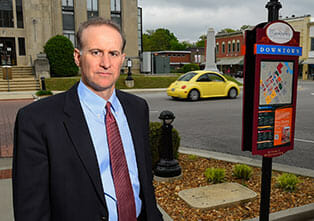Winchester, TN Crosswalk Injury Lawyer
As of March 10, 2017, 21 pedestrian fatalities had occurred on Tennessee roads since the beginning of the year. That’s five more than occurred during the same time the previous year.
One of the pedestrian fatalities in 2017 occurred in Memphis, when a man crossing the street at a crosswalk was struck by a tractor-trailer. The impact threw him into the air and he landed in the street, where another car hit him. A third driver who made contact with the victim stopped, but the other two drivers fled the scene of the crash.
What the Law Says
Tennessee law provides pedestrians the right of way at any intersection, with or without crosswalks. But many drivers fail to slow down when approaching crosswalks, and they aren’t diligent about checking for pedestrians before entering an intersection.
Tennessee Code Section TCA 55-8-134 sets forth the rights of pedestrians who cross the street within a crosswalk. Drivers must yield the right of way to a pedestrian in a crosswalk, slowing or coming to a complete stop if the person is within the crosswalk on the side of the road the vehicle is traveling in. Even if the pedestrian is on the other side, the driver must yield if the person is getting near his half of the road. This assumes, of course, that there are no school-zone flashers or traffic control signals in operation. In that case, the driver must stop and yield.
Additionally, TCA 55-8-134 provides that a vehicle which comes upon another vehicle stopped to yield to a pedestrian must also stop and may not go around the lead vehicle.
If you’ve been injured in a crosswalk accident and believe a reckless or negligent driver is to blame, you may be entitled to compensation. Contact the law office of John R. Colvin to request your free, no-obligation consultation: 1-931-962-1044
Turning Right on Red
During the 1970s, when the cost of gasoline skyrocketed, the Federal Highway Administration enlisted an engineer to determine if allowing right turns on red would result in fuel efficiency gains. At the time, many states did not allow drivers to turn right on red, but after the engineer found that it could save drivers a lot of money on gas, many states enacted laws to allow right turns on red.
The FHWA later observed that allowing right turns on red “had detrimental effects on pedestrians,” because motorists who are looking left for an opening in traffic may turn right without checking for pedestrians. They may also pull so far forward that they’re actually blocking the crosswalk. A 1980 study by the Insurance Institute for Highway Safety found that after cars were legally allowed to turn right on red, the number of right-turn crashes involving pedestrians increased by 57 percent.
High-risk Populations
The IIHS reports that in 2014, 26 percent of pedestrian deaths occurred at intersections. The rate of pedestrian death for people age 70 and older was nearly twice the death rate of pedestrians younger than 70.
Elderly pedestrians may take longer to cross a street than young pedestrians, putting them at higher risk of being hit by a car. When they also have poor vision or diminished reaction time, that risk is even higher, according to the IIHS.
Mechanisms of Injury
In February 2016, two women in the crosswalk at Fourth Avenue and Demonbreun Street, in Nashville, were struck by a car and injured. One woman suffered a shattered ankle, and the other woman was badly bruised.
The severity of a pedestrian’s injuries depends largely on the speed and size of the vehicle. An impact from a tall vehicle, like a truck, can force a pedestrian underneath and result in serious and fatal injuries.
In some instances, the crash victim may be pinned underneath a large vehicle and dragged, as was the case of a woman in Nashville, who was struck by a city bus in 2016 and dragged for nearly 50 yards. An average-size car is more likely to make contact with a pedestrian’s leg, forcing the person onto the hood of the car and perhaps into the windshield. The IIHS says head, leg, and arm injuries are common in pedestrian crashes.
A Lack of Crosswalks
When there is no crosswalk, pedestrians take their chances crossing busy streets, sometimes with fatal consequences. In January 2017, a man crossing Trinity Lane, in Nashville, died when he was hit by a car. It was the second pedestrian fatality on that road in two months, and the man’s fiancée said a lack of crosswalks contributed to the fatal accident.
In the northeastern Tennessee community of Blountville, the Sullivan County Commission instructed the county highway department to install crosswalks where several “near-misses” and at least one serious pedestrian crash had occurred. The area of Cooks Valley Road lies between a church and its other buildings, so pedestrians regularly cross the road there.
Near-misses and Negligent Drivers
Many near-misses are never reported to police, which means the actual risk to pedestrians may be much higher than statistics show. But one incident that was reported in Franklin in 2016 resulted in the arrest of a drunk driver.

When drivers are distracted, aggressive, speeding, or under the influence of drugs and alcohol, they pose a high risk to pedestrians and other drivers. If you were injured in a crosswalk crash and believe a driver’s carelessness was to blame, contact us today to request your free consultation – online, or at 1-931-962-1044.

